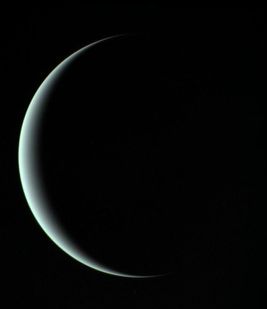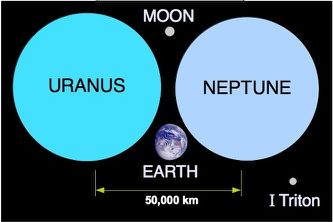URANUS : PHYSICAL CHARACTERISTICSUranus itself is a large-sized bluish or slightly greenish coloured gas planet whose equatorial diameter is around 51,000 kilometres. Even in the largest of telescopes, the planet appears only as bland small but round featureless disk. When compared to Earth, Uranus is 14.5 times larger across, while the mass is almost exactly four times heavier.
Uranus takes about eighty-four years to orbit the Sun, being close to the average human’s lifespan. Compared to all the other planets, Uranus has the peculiarity of rotating in the reverse direction to all the other planets. The pole is spinning on its axis almost perpendicular to its orbital plane at 97.86°. Uranian observers would have sunlight on one hemisphere for forty long years, then darkness for another forty years. A very long dawn and twilight would also last about two years apiece. The planetary equator was last aligned to the ecliptic at 0.0° on the 21st-22nd February 2008 and will again do so in 2050. Earth-bound observers during 2006-2007 saw the Uranian crossing of the equatorial plane. This meant that both the orbital plane of the satellites and rings also appear edgewise. Several transit events were predicted, but very few were observed. Occultations events are virtually all but impossible to see from Earth. A rare example of such an observed event was of Ariel making a shadow transit by the Hubble Space Telescope (HST) on 26th July 2006. The problem with either transits, or even mutual satellite phenomena, is the apparent smallness of the Uranian disk. Transit events are even tinier when compared to the disk, being in the order of 0.4 arcsec or less. Observation by amateurs requires the very largest of apertures and some very good seeing. Also required is some kind of general satellite ephemeris. Such interesting events, of course, are very common to the four main Jovian satellites and seven Saturnian satellites — the latter are either once every 13.25 years then 15.75 years. (Saturn mutual phenomena last occurred in 2009.) Transits do occur over periods of several years around the plane crossings, and in recent times are possibly seen between 2006 and March 2010. Next transit series will again start around 2047. The AtmosphereNot much was real known of the planet until January 1986 when Voyager 2 made its close fly-by. Data revealed little about Uranus itself as it appears to be a rather uninteresting and drab inactive body, especially when compared to atmospheric dynamics of Jupiter and Saturn. This was at the time considered to be mostly due to great distance from the Sun, whose feeble energies did not contribute enough significant heat to the Uranian atmosphere to cause any weather phenomena. Astronomers are yet to be convinced if this inactivity is usual or that the atmosphere might be undergoing a short quiescent phase. 
Figure 2. Voyager 2 Look Back at Uranus :
Image from Voyager 2 in January 1986 showing the Uranian crescent.
The pale blue colour of the planet is obvious. The Different Colours of Uranus and NeptuneObserved colours are matched to the amount of methane in the planetary atmosphere. Methane happens to absorbs much of the faint red-light received from the Sun, which makes Neptune having the richer blue colour. Uranus has approximately the atmospheric composition of 82.5% Hydrogen, 15.2% Helium and 2.6% methane. Neptune is 84% Hydrogen and 15% Helium, with the methane content being mostly the remaining 3%. Uranus appears greener because of the slightly higher temperature of the atmosphere, even though it has slightly less methane. Neptune atmosphere probably also has some more of the colder icy methane. As the chemistry that is happening is not entirely understood, though some inconclusive technical paper on some experiments made in the laboratory has been published. Such very complex upper atmospheres chemistry of these outer planets is likely making these slight colour differences — ‘greener’ with Neptune. Combined with the methane being the main contributor of the ‘blueness’ seen with both planets. Images taken in 2003 and 2004 by the ground-based 10-metre Keck II telescope in Hawaii revealed something unexpected — that the planet now shows clouds, spots and several belts. This suggests Uranus might be more dynamic than once thought, and long term studies into these atmospheric outbursts or some periodic behaviour may be revealed in the years to come. It seems likely that the possible high tilt of the rotational axis probably has some significant effect. This is especially currently noted, as in the beginning of 2005, the temperature along the equator was −150°C. In November 2014, new observations by found new activity in the Uranian atmosphere. Historically, from time to time observers did sometime see very faint band-like features that may traverse the planetary disk. These almost indistinguishable elusive features lead some early observers to tentatively think Uranus rotated about its axis once every 17h 24m. Yet, even though this is reasonably close, this result does differ significantly from the more modern 15h 35m, as often quoted in pre-Voyager 2 astronomical publications prior to 1986. The Uranian atmosphere is composed of a high percentage of methane than the other giant gas planets, which accounts for its bluish, turquoise or cyan coloured appearance. I has been observed that the upper atmosphere of Uranus reaches some 28 kilometres where the winds can be up to about 200 metres per second, while the temperatures at the very edges of the atmosphere are about −220±2°C (53±2K) warming slightly to −197±2°C (76±2K). Composition is approximately 82.5% Hydrogen, 15.2% Helium and 2.6% Methane (CH4). Other gases and compounds exist, but are relatively rarer. These exist principally as aerosols comprising of ices like ammonia (NH3), water (H2O), and ammonia hydrosulfide (NH4).SH — the main coloured gases seen in the visible atmosphere of Jupiter and Saturn. Although not as yet detected, some methane may also exist in its icy state. Comparisons Between Uranus and NeptuneSome General Parameters
For many planetary astronomers, both Uranus and Neptune are seen as close cousins. These near equal Solar System twins share various similarities including size, atmosphere and have similar general nature. For many years Uranus was considered as larger and more massive, but it is now certain that Neptune is equally as significant. Main differences are considered really only in terms of their planetary distances from the Sun and slightly in composition. Sadly, all earth-based observations until very recently could revealed very little. 
Fig. 3. Comparison Between Uranus & Neptune
One of the interesting differences is specifically with the mass and diameters as compared to the Earth. Table 2.
|
| EARTH | URANUS | NEPTUNE | |
| MASS | 5.973×1024 kg. | 8.6832×1025 kg. | 1.024×1026 kg. |
| DIAMETER | 12,756.2 km. | 51,118 km. | 49,532 km. |
Table 3.
Ratios (To Earth)
| EARTH | URANUS | NEPTUNE | |
| MASS | 1.00 | 14.53 | 17.43 |
| DIAMETER | 1.00 | 4.007 | 3.883 |
Table 4.
Comparison Uranus and Neptune
| Uranus to Neptune | Neptune to Uranus | |
| MASS | 0.83362 (16.6% lighter) |
1.1995 (16.6% heavier) |
| DIAMETER | 1.0320 (3.1% larger) |
0.96897 (3.1% smaller) |
Uranus and Neptune are fairly similar in size and mass. By oddly, Uranus is larger than Neptune by 1 586 km. (3.1%) yet is some 16.6% less massive. From this, Uranus is less dense than Neptune. (Density 1.318 g.cm-3 for Uranus to 1.638 g.cm.-3 for Neptune.) This seems to suggest that the core size and compositions might be different. It also indicates that Uranus contains more Hydrogen and Helium. When compared to Earth, Uranus is 14.5 times larger, while by mass it is almost exactly four times heavier.
NEXT PAGE : The URANIAN MOONS and RINGS
Disclaimer : The user applying this data for any purpose forgoes any liability against the author. None of the information should be used for either legal or medical purposes. Although the data is accurate as possible some errors might be present. Onus of its use is placed solely with the user.
Last Update : 23rd April 2018
Southern Astronomical Delights © (2018)







